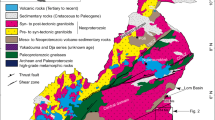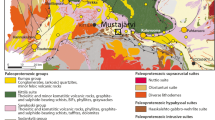Abstract
The Golden Pride gold deposit (∼3 Moz) is located in the central part of the Nzega Greenstone Belt at the southern margin of the Lake Victoria Goldfields in Tanzania. It represents an inferred Late Archaean, orogenic gold deposit and is hosted in intensely deformed meta-sedimentary rocks in the hanging wall of the approximately E–W striking Golden Pride Shear Zone. The hanging-wall sequence also includes felsic (quartz porphyritic) to mafic (lamprophyric) intrusions, as well as banded iron formations. Hydrothermal alteration phases associated with mineralisation are dominated by sericite and chlorite. Two main ore types can be distinguished, chlorite and silica ore, both occupying dilational sites and structural intersections in the hanging wall of the main shear zone. Sulphide minerals in both ore types include pyrrhotite, arsenopyrite, pyrite and accessory sphalerite, galena, sulphosalts and Ni–Co–Bi sulphides. Gold and tellurides are late in the paragenetic sequence and associated with a secondary phase of pyrrhotite deposition. Sulphur isotope compositions range from −6 to 7 per mil and are interpreted to reflect contributions from two distinct sources to the mineralising fluids in the Golden Pride gold deposit. A redox change, potentially induced by the intrusion of mafic melts, together with structural elements in the hanging wall of the Golden Pride Shear Zone, are interpreted to be the main controls on gold mineralisation in this deposit.











Similar content being viewed by others
References
Bierlein FP, Arne DC, McKnight S, Lu J, Reeves S, Besanko J, Marek J, Cooke D (2000) Wall-Rock petrology and geochemistry in alteration halos associated with mesothermal gold mineralisation, Central Victoria, Australia. Econ Geol 85:283–311
Borg G (1990) A preliminary report on the geology of the Siga Hills, NW Tanzania. Part I: Regional geology, geophysics, geochemistry and distribution of gold within the project area: Tanzanian–German Technical Cooperation, BGR internal report, Archive no. 108564. pp77.
Borg G, Krogh T (1999) Isotopic age data of single zircons from the Archaean Sukumaland Greenstone Belt, Tanzania. J Afr Earth Sci 29:301–312
Borg G, Shackleton RM (1997) The Tanzania and NE Zaire cratons. In: DeWit M, Ashwal LD (eds) Greenstone belts. Oxford University Press, Oxford, pp 608–619
Chamberlain CM, Tosdal RM (2007) U–Pb geochronology of the Lake Victoria Greenstone Terranes. Confidential report to project sponsors. Mineral Deposits Research Unit, University of British Columbia, Vancouver, BC 81p
Cox SF (1999) Deformational controls on the dynamics of fluid flow in mesothermal gold systems. Geol Soc Lond Spec Pub 155:123–140
Cox SF, Sun SS, Etheridge MA, Wall VJ, Potter TF (1995) Structural and geochemical controls on the development of turbidite-hosted gold–quartz vein deposits, Wattle Gully Mine, central Victoria, Australia. Econ Geol 90:1722–1746
Groves DI, Goldfarb RJ, Gebre-Mariam M, Hagemann SG, Robert F (1998) Orogenic gold deposits: a proposed classification in the context of their crustal distribution and relationship to other gold deposit types. Ore Geol Rev 13:7–27
Groves DI, Goldfarb RJ, Robert F, Hart CJR (2003) Gold deposits in metamorphic belts: overview of current understanding, outstanding problems, future research and exploration significance. Econ Geol 98:1–19
Hagemann SG, Cassidy KF (2000) Archaean orogenic lode gold deposits. Rev Econ Geol 13:9–68
Harpum JR (1970) Summary of the geology of Tanganyika. Part V; structure and geotectonics of the Precambrian. Geol Surv Tanganyika Mem 2:1–58
Huston DL, Power M, Gemmell JB, Large RR (1995) Design, calibration and geological application of the first operational Australian laser ablation sulphur isotope microprobe. Aust J Earth Sci 42:549–555
Kabete JM, Groves DI, McNaughton NJ, Mruma AH (2008) A new tectonic subdivision of the Archean of Tanzania and its significance to gold metallogeny. SEG-GSSA 2008 Africa Uncovered Conference—Abstr Vol, pp 21–25
Kerrich R, Wyman DA (1994) The mesothermal gold-lamprophyre association: significance for an accretionary geodynamic setting, supercontinent cycles, and metallogenic processes. Mineral Petrol 51:147–172
Lambert IB, Phillips GN, Groves D (1984) Sulphur isotope compositions and genesis of Archaean gold mineralisation, Australia and Zimbabwe. In: Foster RP (ed) Gold '82; the geology, geochemistry and genesis of gold deposits, Geol Soc Zimbabwe. Balkema, Rotterdam, pp 373–387
McCuaig TC, Kerrich R (1998) P-T-t-deformation-fluid characteristics of lode-gold deposits: evidence from alteration systematics. Ore Geol Rev 12:381–453
Morey AA, Tomkins AG, Bierlein FP, Weinberg RF, Davidson GJ (2008) Bimodal distribution of gold in pyrite and arsenopyrite: examples from the Archaean Boorara and Bardoc Shear Systems, Yilgarn Craton, Western Australia. Econ Geol 103:599–614
Ohmoto H (1986) Stable isotope geochemistry of ore deposits. In: Valley JW, Taylor HP, O'Neil JR (eds) Stable isotopes in high temperature geological processes. Reviews in Mineralogy 16. Mineralogical Society of America, Washington, DC, pp 491–560
Stevens R, Kennedy R (1998) The Golden pride Gold Deposit Tanzania. AIG Bull 25:3–8
Tulloch AJ, Kimbrough DL (2003) Paired plutonic belts in convergent margins and the development of high Sr/Y magmatism: Peninsular Ranges batholith of Baja-California and Median Batholith of New Zealand. Geol Soc Am Spec Publ 374:275–295
Vos IMA, Halley SH, Christie MHD (2007) Targeting Gold deposits along a regional shear zone: a case study from the Archaean Golden Pride deposit in Tanzania. In: Milkereit B (ed) Proceedings of Exploration 07: Fifth Decennial International Conference on Mineral Exploration, pp 953–956
Weinberg RF, Groves DI, Hodkiewicz PF, Van Der Borgh P (2002) Hydrothermal systems, giant ore deposits and a new paradigm for predictive mineral exploration. AMIRA Project P511, Yilgarn Atlas Vol. 3 (unpubl.), pp 140–170
Wilson M (1989) Igneous petrogenesis. Kluwer, Dordrecht p 450
Acknowledgements
The authors wish to express their gratitude to Jigsaw Geoscience Pty. Ltd.’s Kas De Luca and Ian Neilson for their valuable contributions. In addition, Scott Halley of Mineral Mapping Pty. Ltd. has contributed his geological knowledge, in particular in relation to lithogeochemistry and recognising the various alteration styles. Prof. Anthony J. Crawford (University of Tasmania) and Dr. Doug Mason (Mason Geoscience Pty. Ltd.) both conducted petrographical studies, respectively, on intrusive and sedimentary (as well as ore-related) rocks from the Golden Pride gold deposit that contributed to the understanding of the lithologies and mineralisation styles. Stafford McKnight has dedicated his time and knowledge to assist with SEM work at the University of Ballarat. Andrew Goode is thanked for reviewing an early version of the manuscript and providing valuable comments. The authors wish to acknowledge the support of the CEO and General Manager Exploration from Resolute Mining Ltd. in approving publication of this paper. Revision of the manuscript was aided by constructive comments from the reviewers Basem Zoheir and Gregor Borg, and the editor, Bernd Lehmann. Their support is greatly appreciated.
Author information
Authors and Affiliations
Corresponding author
Additional information
Editorial handling: B. Lehmann
Electronic supplementary material
Table 1
Whole-rock (XRF-in wt.%) and multi-element (ICP-MS-in ppm) geochemical data for selected rock suites of the Golden Pride mine stratigraphy. GPSZ = Golden Pride Shear Zone, relating to intensely foliated and carbonate-altered rocks defining the shear zone. (XLS 28 kb)
Table 2
Representative EDS analyses for ore mineral phases at the Golden Pride gold deposit. All values in atomic percent. System resolution is 53–60 eV. Data reduction by ZAF (two iterations). Standards used were pure elements except for sulphur (marcasite), zinc (sphalerite) and arsenic (arsenopyrite). (XLS 34 kb)
Table 3
In situ laser and conventional sulphur isotope data of representative iron sulphide samples from the Golden Pride gold deposit. Correction factors (w.r.t. CDT) for laser ablation: \({\text{arsenopyrite}} = {\delta ^{34}}{\text{S}} \times 1.105 + 5.00;\,{\text{pyrrhotite}} = {\delta ^{34}}{\text{S}} \times 1.105 + 3.48;\,{\text{pyrite}} = {\delta ^{34}}{\text{S}} \times 1.105 + 5.11\). Carbonate separation done for all samples. (XLS 36 kb)
Rights and permissions
About this article
Cite this article
Vos, I.M.A., Bierlein, F.P., Standing, J.S. et al. The geology and mineralisation at the Golden Pride gold deposit, Nzega Greenstone Belt, Tanzania. Miner Deposita 44, 751–764 (2009). https://doi.org/10.1007/s00126-009-0245-3
Received:
Accepted:
Published:
Issue Date:
DOI: https://doi.org/10.1007/s00126-009-0245-3




